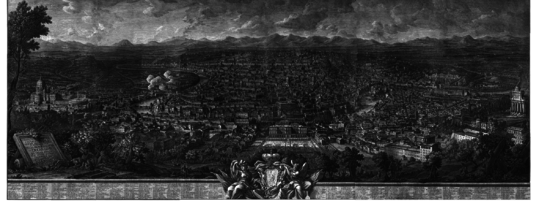Villa Lante al Gianicolo
| Villa Lante al Gianicolo | |
|---|---|
 View of Villa Lante, entrance facade | |
 Click on the map for a fullscreen view | |
| General information | |
| Location | Rome |
| Coordinates | 41°53′35.14″N 12°27′38.51″E / 41.8930944°N 12.4606972°E |




Villa Lante al Gianicolo is a villa in
Architecture
The site is on the edge of the flat top of the Janiculum Hill, which here begins to slope steeply down terraces, and the large loggia built facing the view is on the same level as the front door on the other side of the house, which is reached by some gentle steps from the entrance courtyard. But below the loggia there is a considerable drop to the ground, and after a narrow garden terrace, another sharp drop to the next terrace below. To the side of the house a larger garden on a flat terrace also gives splendid views; unlike the house itself this is open to the public.[2]
Turini was a Papal official (the "datary") who was a close friend of Raphael, and supervised the building of his tomb in the Pantheon, Rome. Raphael would no doubt have been the architect if he had lived longer, and may have made plans for it before his death. The building repeats many features of the Villa Madama, which was further advanced by Raphael's death, and also taken over by Giulio Romano.[3]
Romano made the whole building suggest lightness and elegance to exploit the ridge-top position and overcome the rather small Roman footprint. The orders are delicate, with
There are extensive frescos and decoration in stucco in the rooms, carried out by Raphael's workshop team under the supervision of Giulio Romano, with Polidoro da Caravaggio probably playing a leading part. These had subjects from Roman history designed to appeal to Pope Leo X, who died in 1521 before they were completed. Turini lost his job in the brief reign of Pope Adrian VI (1522–23), and they were not completed until he resumed it in 1523.[5] Other parts of the interior decoration, including the Neoclassical reliefs, date from a redecoration at the beginning of the 19th century.
Artists recording the view
One of Martial's Epigrams, which is now inscribed on a tablet in the loggia, describes the view from his house (which in fact seems to have been on the
The view of the city was one of the most famous, and recorded by many artists.
Later history
The villa came into the ownership of
Notes
- ^ Talvacchia
- ^ Talvacchia
- ^ Hall, 160
- ^ Talvacchia
- ^ Hall, 160
- ^ Book 4, 64, 11-12
- ^ "Joseph Mallord William Turner, View of Rome from the Villa Lante on the Janiculum Hill, 1819", Tate Britain
- ^ "Castle Goring - Summary". Strutt and Parker Estate Agents. Archived from the original on 16 April 2013. Retrieved 13 March 2013.
References
- Fiori, Nica (1994). Le ville di Roma entro le mura. Rome. ISBN 88-7983-503-3.)
{{cite book}}: CS1 maint: location missing publisher (link - ISBN 0521624452, 9780521624459, google books
- Talvacchia, Bette, "Giulio Romano." Grove Art Online, Oxford Art Online, Oxford University Press, accessed March 30, 2016, subscription required
